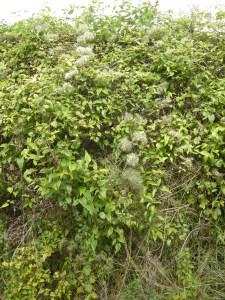
Clematis vitalba seed head (13/09/2011, Southend On Sea)
Position: Full sun to partial shade
Flowering period: Summer
Soil: Well drained soils
Eventual Height: 15m
Eventual Spread: 15m
Hardiness: USDA Zones 4a – 9b
Family: Ranunculaceae
C. vitalba is a deciduous climbing shrub with woody stems growing up to 15m in height at a fast growth rate. It has branched, grooved and woody stems that can grow 20-30m long. It climbs by twining its petioles (leaf stalks) around a convenient support. The leaves are opposite, pinnately compound, consisting of 5 leaflets with entire leaf margins, the upper leaflet is sometimes 3 lobed. The hermaphrodite flowers, produced in the summer months, are white to greenish white and are about 2cm in diameter. The inflorescene of C. vitalba is a terminal axillary panicle and the flowers are found in stalked clusters and are accompanied by fluffy underlying styles that become elongated. The fruit of the plant, produced in autumn, is an achene and contains long silky hairs which aids its dispersal by the wind.
C.vitalba, commonly known as Old man’s beard or Travellers Joy, is native to parts of Europe from Holland to the Caucasus, including southern Britain. This plant is an unwanted organism in New Zealand as its growth is vigorous and has no natural controlling organisms in that country. It should be noted, all parts of the plant are poisonous although there are no records of human death, this is most likely due to this plant’s extremely acrid taste.
The name Clematis is a Latinised form of the Greek word klēmatis meaning ‘climbing‘. The term Vitalba is derived from the Greek term for ‘white vine’.

Clematis vitalba (13/09/2011, Southend On Sea)
The landscape architect may find this plant useful in a native planting scheme. It will form an important component of the mixed native hedge due to its wildlife benefit. It my also be specified for the wild life garden.
Ecologically this plant is beneficial for wildlife. Birds such as the Goldfinch and Greenfinch feed on the seed-heads but many more birds may use it to nest in using the fluffy material for seed bedding. Small emerald and chalk carpet moths may feed on the foliage.
This plant prefers chalky and limestone areas. In Europe this species is found in weakly acidic to weakly basic soils, fertile soils with good drainage, usually moist and quite deep. The roots of the plant should also be planted in the shade.
Maintenance: This large climbing plant should not require too much maintenance if planted in the correct location.

